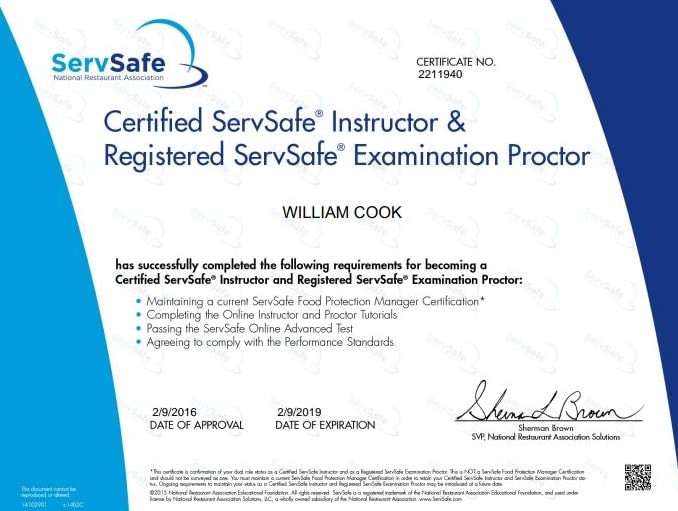Comprehending the Function of a ServSafe Food Handler in Ensuring Food Safety Requirements
Comprehending the Function of a ServSafe Food Handler in Ensuring Food Safety Requirements
Blog Article
Effective and quick Food Handlers Educating for Certification
In the food service sector, the value of quick and effective food trainers training for qualification can not be overemphasized. Appropriate training guarantees that workers are well-informed concerning essential food safety practices, inevitably protecting public wellness and boosting functional efficiency.
Relevance of Food Safety And Security Training
Although food safety training may seem like a basic demand for food trainers, its relevance can not be overemphasized. The food market is inherently prone to a variety of wellness risks, consisting of foodborne diseases that can arise from incorrect handling, storage space, and preparation practices. Efficient training gears up food trainers with the expertise required to alleviate these risks, thus making certain the safety and security and quality of the food being served.
Moreover, food security training promotes a society of accountability and diligence amongst personnel. When workers understand the essential duty they play in maintaining health requirements, they are a lot more most likely to abide by methods and record prospective threats. This proactive strategy not only protects consumers however likewise boosts the credibility of the establishment.
Thus, spending in detailed food security training is not merely a lawful formality yet a critical choice that safeguards public wellness and sustains organization stability. Inevitably, the relevance of food security training extends beyond individual responsibility; it is a fundamental aspect that sustains the stability of the entire food supply chain.
Secret Elements of Training Programs

To start with, the training content should cover critical topics such as cross-contamination, appropriate food storage, temperature control, and individual health techniques (servsafe certifications). This makes certain that food handlers are fluent in the vital principles of food safety and security
Secondly, the educational methods utilized in training programs play an essential role in boosting understanding and retention. Using a mix of interactive strategies, such as hands-on demonstrations, seminar, and multimedia discussions, can provide to varied discovering designs and improve engagement.
Lastly, robust evaluation techniques are vital for evaluating the effectiveness of the training program. Executing tests, practical evaluations, and real-world circumstances not just aids in enhancing knowledge yet additionally ensures that food handlers can use what they have learned in their everyday jobs.
Advantages of Quick Certification
Fast accreditation in food handling uses various benefits, particularly in today's fast-paced food sector. Among one of the most substantial advantages is the capability to swiftly gear up employees with vital expertise and abilities, making sure conformity with wellness regulations. This accelerates the onboarding process, allowing dining establishments and food service establishments to preserve operations without lengthy delays.
Furthermore, rapid accreditation programs are typically much more easily accessible, fitting a diverse variety of learning designs and timetables. These programs commonly use engaging methods such as on the internet modules or interactive workshops, which can boost retention of critical information.

Additionally, fast certification can reduce the danger of foodborne ailments, which can substantially influence a service's track record and lower line. By making sure that all workers are quickly trained and certified, facilities can foster a culture of food safety, ultimately benefiting both business and its customers. On the whole, quick certification stands for a critical advantage in go to the website an affordable industry.
Tips for Effective Implementation

Effective execution of food trainer training programs is important for maximizing the benefits of fast qualification. To achieve this, organizations should begin by plainly specifying their training objectives and straightening them with regulatory requirements. This makes certain that all needed subjects are covered adequately.
Using modern technology can streamline the training procedure. Online modules enable versatile scheduling, enabling staff members to complete training at their comfort while reducing downtime. Integrating interactive aspects, such as quizzes and scenario-based discovering, can improve interaction and retention of information.
It is likewise vital to develop an organized timeline for training sessions, allowing ample time for both direction and useful application - servsafe food handler. This may include hands-on demos of proper food handling techniques, which are important for strengthening understanding
Regular communication with staff about training expectations and end results cultivates a society of liability and urges engagement. Offering accessibility to additional sources and assistance materials can enhance understanding and resolve any type of lingering concerns.
Evaluating Training Efficiency
Evaluating the performance of food trainer training programs is critical for ensuring that staff members not just acquire the necessary knowledge yet likewise apply it in their day-to-day tasks. A comprehensive analysis procedure can include a number of techniques, consisting of pre- and post-training evaluations, direct monitorings of food managing practices, and employee comments studies.
Pre- and post-training evaluations assist to measure the expertise acquired by employees, providing quantitative information that can indicate the performance of the website link training material. servsafe manager. These assessments ought to cover important topics such as food safety and security regulations, individual health standards, and cross-contamination avoidance
Direct observations of staff members in their workplace are vital for analyzing the functional application of discovered abilities. Observations permit trainers and monitoring to determine locations where staff members may battle and require extra assistance or re-training.
Moreover, collecting responses with surveys from participants can use insights right into the training's importance, pacing, and general efficiency. Engaging workers in this responses procedure can foster a society of continuous improvement.
Verdict
In conclusion, quickly and reliable food handlers training for qualification is vital for maintaining high food safety requirements. Continuous evaluation of training performance additionally makes certain that food security practices stay existing and reliable in a vibrant industry atmosphere.
In the food service industry, the relevance of fast and effective food handlers educating for accreditation can not be overemphasized.Although food safety and security training might appear like a fundamental demand for food trainers, its value can not be overstated. Efficient training furnishes food handlers with the knowledge required to reduce these risks, consequently making certain the safety and security and top quality of the food being served.
Ultimately, the value of food security training extends past individual obligation; it is a foundational element that supports the honesty of the whole food supply chain.
In verdict, quickly and effective food handlers training for certification is important for preserving high food safety standards.
Report this page